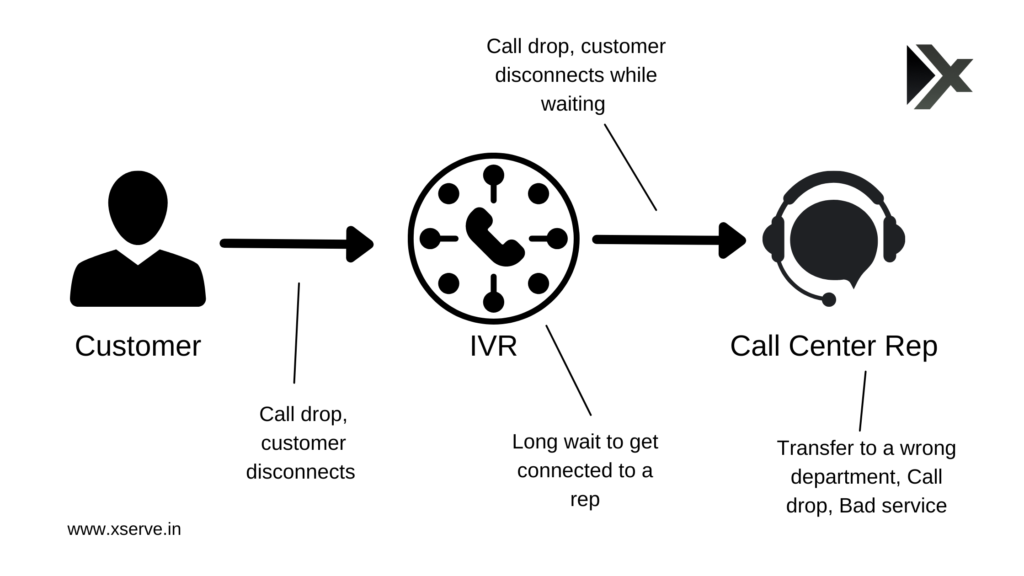Call Center service level is a measure of efficiency. It measures what percentage of calls were answered within a specified amount of time. For instance, 80% of all calls were answered within 20 seconds. Service level usually has a direct positive correlation to customer satisfaction. The higher the service level, higher the customer satisfaction. Customers would be happier if calls were answered promptly by the call center reps. Nobody likes the IVR or waiting in the queue. While the impact could vary, it can’t be denied that call center service level affects customer perception and satisfaction. Do you measure service level for your customer helpdesk? Do you measure it right?
Measuring Call Center “Service” Level
There can’t be any one measure of the service efficiency. At best, the most common definition and measurement (a certain percentage of calls answered within a specified time) measures efficiency of one failure point. It reports what percentage of customers, when the call was answered, had to wait for less than the pre-defined maximum wait time. If 20 seconds is the specified upper limit and 100 calls were answered, how many of those 100 were answered within 20 seconds.
This is an important metric. However, it does not capture a few other important service level indicators.

What are some other indicators to measure call center service level efficiency?
All call attempts by customers need to be considered while measuring service level efficiency. Along with answered calls, we need to measure call abandons as well as the call wait time.
Call Abandon Rate
This measures what percentage of calls were dropped before the call was answered by a customer care representative. The call drop could be due to a network glitch or maybe the customer did not want to wait too long to talk to a rep. The customer may hang up if the IVR options were not clear. Whatever the reason, you would not want any customer to hang up or the call getting abandoned before the query could be resolved. Not just service level, this also impacts the overall customer satisfaction.
Average Call Wait Time
Measure this for both set of calls – calls answered and abandoned calls. On an average, how long do customers have to wait before a service rep answers the call? How long do customers wait in the queue before a call is abandoned? Along with other service level KPIs, this measures the speed of service and should be used to determine the call center staffing and scheduling.
Longest Delay in Queue
Averages could be misleading. If 90% of all calls were answered within 5 seconds and the remaining 10% of callers had to wait for 2 minutes, the overall average time to answer would be 16.50 seconds. This seems fine, however how satisfied were the 10% customers who had an average wait time of 2 minutes. If the average for 10% callers was 2 minutes, there would be a few who had to wait for longer than 5 minutes. Hence measuring longest delay in queue is a good idea.
Along with this, you could also measure what percentage of callers had to wait for more than a specified time before the call was either answered or abandoned? For example, you could set a goal that not more than 5% calls should be in the queue for more than 60 seconds.
Average Call Handling Time
This again is a measure of speed of service. How long does it take to greet a caller, understand the query and provide a solution. You need to find a sweet spot between average call handling time (ACHT or AHT) and customer satisfaction. You do not want call center reps to rush through calls to ensure a lower call time at the expense of customer satisfaction. At the same time, you do not want reps to drag calls unnecessarily while there are other callers waiting in the queue.
Short Calls
Along with ACHT, you also need to check what percentage of calls are completed in a short span of time. Suppose the average call handling time is 2 minutes 30 seconds. Given the call flow, you can determine the lowest possible duration for all valid calls. There are bound to be some invalid calls like customers selecting a wrong department in the IVR. However any call that’s over in less than 15 seconds or 30 seconds should be investigated.
More short calls could be either due to a poor IVR structure or it could be a targeted attempt by the call center to lower the average call handling time. Either you need to fix the call architecture or prevent unethical call practices. Hence, measuring the percentage of short calls is a good practice.
Manage Service Levels for Customer Satisfaction and Retention
No one measure can provide complete visibility. Hence, along with other important call center KPIs, measure these service level KPIs:
- Service Level: Percentage of calls answered within a specified time (80% calls answered within 20 seconds)
- Call Abandon Rate: Unanswered calls. Percentage of calls disconnected before a call center rep could answer the call. (3% calls were abandoned before being connected to a rep)
- Average call wait time: How much time do customers have to wait before the call gets answered or abandoned (customers have to wait 45 seconds in the queue before the call gets answered)
- Longest Delay in Queue: This measures the longest wait time for all calls received (One customer had to wait for 12 minutes in the queue). You should also measure what percentage of callers had to wait for more than a specified time before the call was answered (7% customers had to wait for 5 minutes or more)
- Average Call Handling Time: On an average, how much time do reps take to answer calls and resolve the query
- Short Calls: The percentage of calls that are disconnected in a short span of time after being answered by a rep (3% calls lasted for 10 seconds of less)
These call center service level KPIs will give you a clear indication on how well are you able to service your customers. The trend and insights help you determine the call center staffing and scheduling patterns for highest levels of customer service.


1 comment